All about feeding cucumbers
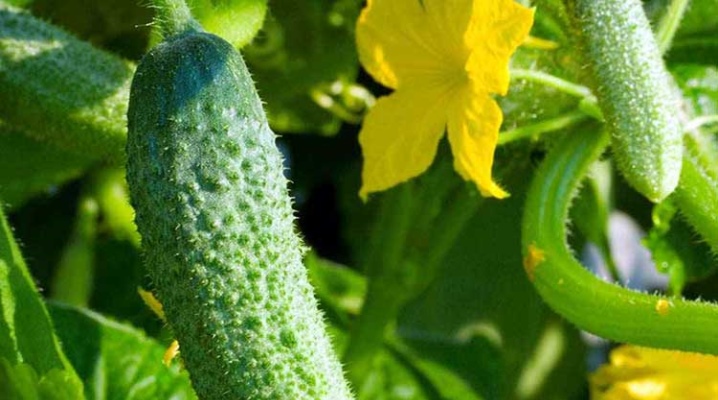
Cucumber is a crop that requires a certain soil composition. Lack of essential nutrients affects yields. Therefore, it is so important to feed the vegetable correctly and on time.
Fertilizers
Fertilizers differ in the method of their production, chemical composition and the nature of the effect of the existing components on the plant. They are divided into 2 types.
Mineral
Mineral fertilizers have a high concentration of the main nutrient, therefore they act quickly and efficiently. In their composition, they can be simple and complex. Simple top dressing contains one component: nitrogen, potassium or phosphorus.
- Nitrogen fertilizing - ammonium nitrate, urea. They are necessary to stimulate the green mass of cucumbers - stems, leaves - and the formation of ovaries, since nitrogen participates in the metabolic processes of the plant and is an integral part of the cytoplasm, proteins, enzymes and chlorophyll.
- Potash fertilizers - potassium chloride, potassium sulfate and potassium salt. Potassium stimulates the process of photosynthesis, participates in the synthesis of sugars and carbohydrates, promotes the movement of carbohydrates from the leaves to other parts of the plant, thereby increasing the yield and quality of cucumbers.
- Phosphate fertilizing - superphosphate (simple and double), phosphate rock. Phosphorus, being an energy source, regulates metabolic processes, influences protein synthesis. It has a beneficial effect on the development of the root system, flowering, formation and maturation of cucumbers.

Complex mineral fertilizers can consist of all or individual nutrients with the addition of micro and macro elements, the content of which is correctly balanced.
The most commonly used types of these fertilizers:
- nitroammofosk, nitrophoska, azofosk, ammophos, containing all 3 elements: nitrogen, phosphorus and potassium;
- diammophos contains phosphorus and nitrogen;
- "Master-Agro" - in addition to nitrogen (22%), phosphorus (8%) and potassium (16%), includes micro- and macroelements (copper, zinc, magnesium, iron, molybdenum).
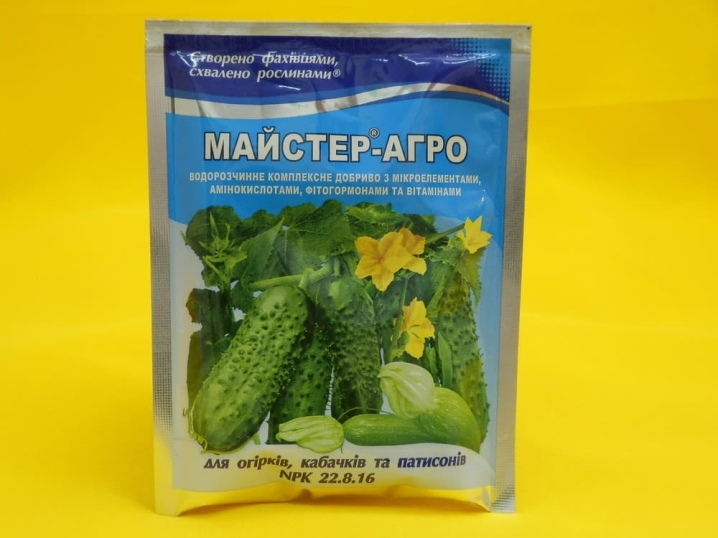
Organic
Organic, being a natural product of natural origin, is considered safe for people. Its peculiarity lies in the fact that it takes some time for the process of decomposition and release of nutrients. Therefore, organics have a longer period of action.
Organic fertilizers help to improve the structure of the soil, making it looser and lighter, good moisture and air permeability.
Types of organics.
- Manure - cow, horse - is the most popular type of organic matter, rich in nutrients (especially nitrogen). However, only well-rotted manure can be used, not fresh manure, since it can contain various infections, harmful insects and their larvae, weed seeds.
- Compost... It is formed as a result of the decomposition of food and plant waste (vegetable peelings, tops, weeds and other vegetation). Compost has a high content of all 3 components necessary for cucumbers.
- Bird (chicken) droppings... In addition to essential nutrients, it contains bacteriophages that kill harmful bacteria in the soil.
- Siderata (green fertilizer)... They replenish the composition of trace elements in the soil, protect the soil from erosion and blowing off the surface layer by the wind, and suppress the growth of weeds. The cut grass is also used as a mulch, which helps to retain moisture and provide nutrients.Different types of cereals, legumes and clover, mustard, lupine and other plants serve as siderates.
- Bone flour... It is rich in phosphorus and potassium, but does not contain nitrogen, so it is used to reduce the acidity of the soil.
- Wood ash it has a high content of potassium, phosphorus, iron, magnesium, manganese and boron.


Feeding mode
The effectiveness of the use of fertilizers largely depends on the timeliness of their application. It is recommended to feed cucumbers once every 2 weeks. The feeding regimen usually includes such stages.
- First feeding... It is carried out 15 days after the cucumbers are planted.
- The second feeding is done during the formation of buds and in the initial stage of flowering.
- Third once fertilized during the period of mass fruit setting and active fruiting.
- Last fourth top dressing is done at the end of the summer period in order to prolong fruiting.
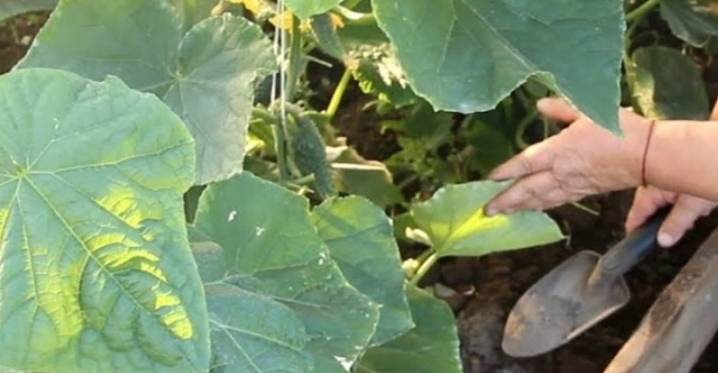
How to understand what to fertilize with?
The lack of certain nutritional components affects the development of cucumbers and causes changes in their appearance. Certain signs can tell you which elements are missing.
Lack of nitrogen leads to slow growth of lashes, yellowing of leaves from the central vein. Cucumbers thicken at the stalk, and the tips become narrow.
A lack of potassium causes the following changes:
- leaves and whips grow very quickly and become large;
- the tops become dark green;
- the lower leaves become lighter, and a dried yellow edging forms along the edge;
- cucumbers become pear-shaped.
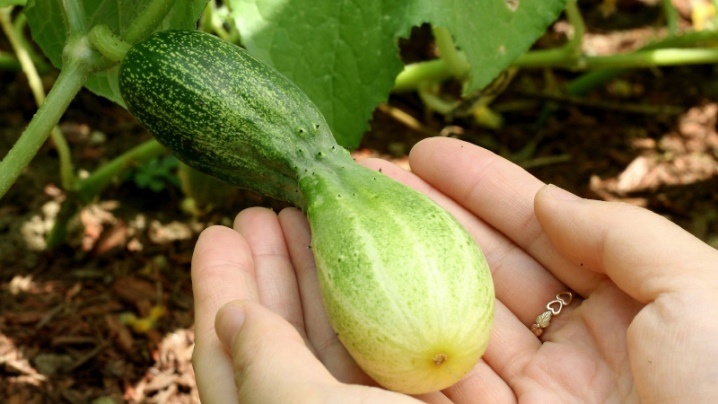
Phosphorus deficiency manifests itself in the slow development of lashes and leaves... New young leaves are smaller in size than old ones, and young tops are darker in color and dry out quickly. The lack of trace elements is indicated by the yellow color of the leaves.... Spraying with solutions of complex fertilizers containing the main elements: manganese, iron, zinc and others will help. If these defects are detected, appropriate fertilizers should be applied.
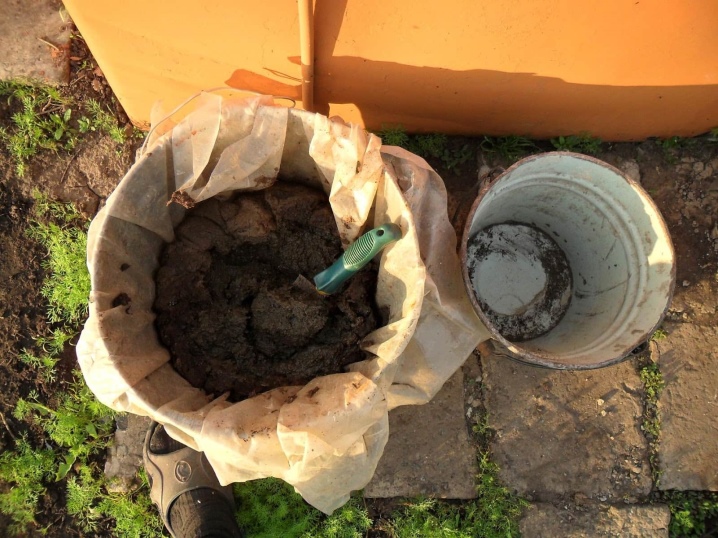
How and when to feed?
There are 2 ways of feeding - root and foliar. Root dressing is used if the summer is warm and the roots of the plant develop well. They should be applied to damp ground after watering or rain in the evening. Fertilizing during the day can only be done in cloudy weather..
Foliar are more effective if the summer is cool with a predominance of cloudy weather. This weather is not conducive to the full development of roots, and fertilizers will not be fully absorbed. Therefore, it is necessary to spray cucumbers with liquid dressings.
The solution should be applied from a spray bottle, evenly covering the leaves so that the dressing stays on the foliage for as long as possible.
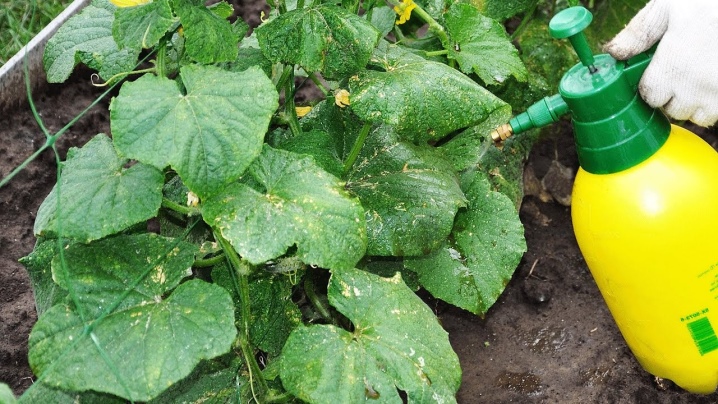
To have a good harvest of cucumbers, it is necessary not only to feed them, but also to do it right. The use of certain types of dressings is carried out in accordance with the stages of the vegetation of the plant, observing the correct dosage and fertilization regimen.
Preparing the soil for the next harvest begins in the fall... During the digging of the soil, it is recommended to introduce organic matter: in winter, under the snow, the process of its decay will take place with the release and accumulation of nutrients. At the same time, bone meal and ash are added to acidified soil to reduce acidity. In the autumn period, it is also possible to use dry potash (30 g / m2) and phosphorus (50 g / m2) dressings.
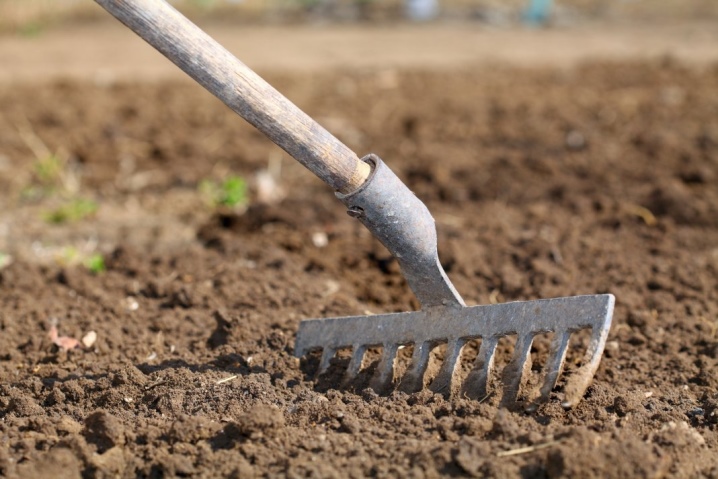
When growing cucumber seedlings at home on a windowsill, fertilizers are applied to the substrate or 2-3 weeks after planting the seeds. Cucumbers should be fed with solutions of nitrogen-containing drugs (urea) or bird droppings, which are used to water the soil under the root, not irrigate the foliage.
When planting seeds directly on a garden bed in open ground, humus (rotted manure) mixed with straw is added to the holes and covered with a layer of soil - so the roots of the cucumbers will not directly come into contact with organic fertilizers.Another method is also used: in advance - 2 weeks before sowing the seeds - they apply liquid fertilizers based on complex compositions or an ash solution. The composition of solutions for a bucket of water: urea (20 g), superphosphate (30 g), potassium chloride (10 g) or 1 glass of ash. These solutions are watered either 1/2 l wells, or the entire garden.
In the future, the vegetable should be fertilized in accordance with the schedule.

After landing in the ground
After sowing seeds in the soil, organic matter can be used only if it was not used in the preparation of the soil. Cucumbers are fertilized when 2-3 leaves are formed at the seedlings. Cucumber seedlings planted in the ground should be fertilized only 10 or 12 days after transplanting, when they are well rooted and adaptable.
The first feeding must necessarily contain nitrogen for the full development of the root system. Particularly effective is ammonium nitrogen, which is contained in urea, ammonium sulfate.
To prepare solutions, you can use ready-made mineral preparations, which are dissolved in 1 bucket of water:
- urea and potassium sulfate (10 g each), superphosphate (20 g);
- urea (1 tbsp. l.) and superphosphate (60 g);
- ammonium nitrate, superphosphate and potassium salt (10 g each).
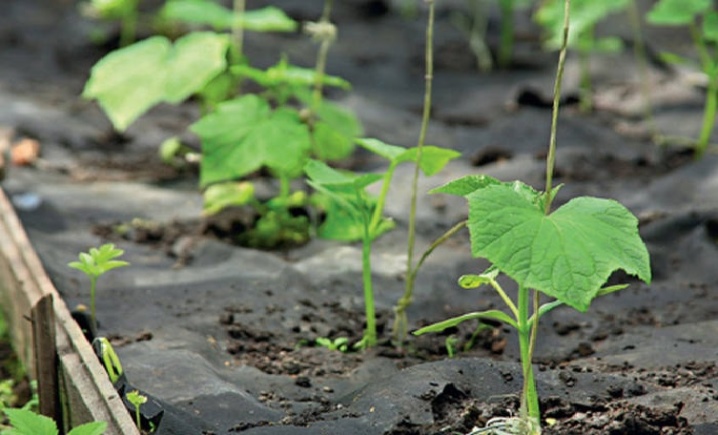
You can also sprinkle the soil with dry ammophos (5 g), followed by loosening.
Organic solutions can also be prepared.
- Manure (1 kg), chicken droppings (1/2 kg), urea (2 tbsp. L.) Are diluted in 10 liters of water. A liter of this solution is diluted again with 10 liters of water and the resulting working composition is watered with the plants up to 3 times in 7 days, 500 g for each cucumber bush.
- Bird droppings diluted in water in a ratio of 1:15 and used immediately after preparation.
- Liquid mullein diluted with water in a ratio of 1: 8.
- Herbal infusion diluted with water 1: 5.

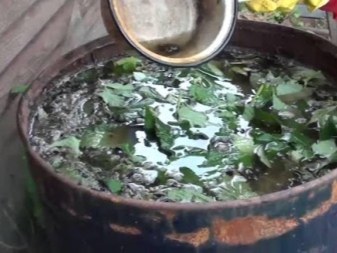
During flowering and fruiting
The flowering and ovary formation of cucumbers is a continuous process, so the vegetable requires a lot of nutrients. The second time the cucumbers are fertilized when flowering begins and the first fruits are tied. At this time, potassium, phosphorus and trace elements are the basis of plant nutrition. Both complex and folk, independently prepared means are used.
For example: 10 g of ammonium nitrate, 10 to 15 g of superphosphate, 15 g of potassium salt per bucket of water. Or: ammonium nitrate (30 g), potassium nitrate (20 g) and superphosphate (40 g) also in a bucket of water.
It is also recommended to use the following fertilization methods:
- a mixture of superphosphate and dry ash is introduced into the ground, followed by loosening;
- sprinkle the ground under the bushes with ash (2 tablespoons per bush) and at the same time spray with milk whey with the addition of a few drops of iodine;
- spray with a solution of boric acid with potassium permanganate and then pour over the banana peel infusion;
- pour with an aqueous solution of ash (dissolve 2 glasses in 10 liters), followed by mulching with compost;
- pour with herbal infusion diluted with water 1: 5.
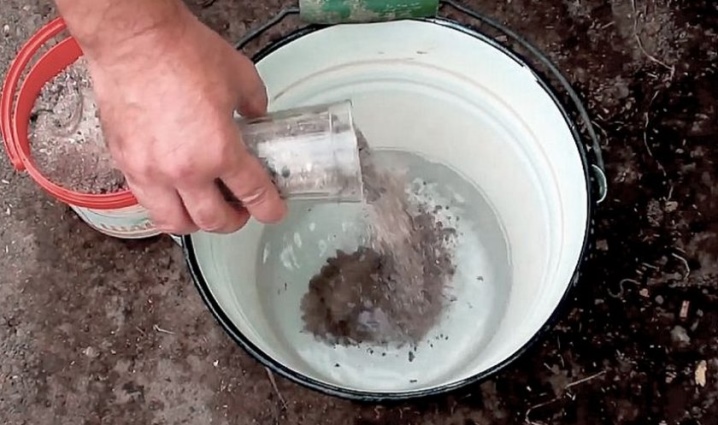
For foliar spraying, solutions are prepared:
- superphosphate - 35 g per bucket of water;
- boric acid (1 tsp) and several (10-12) grains of potassium permanganate per 1 liter of water.
In the phase of active fruiting, the next feeding is carried out using organic matter with the addition of mineral components.
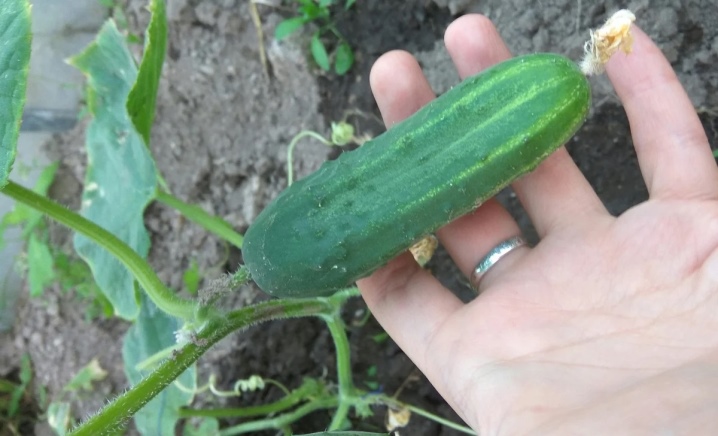
You can stick to this fertilization method. For 10 liters of aqueous solutions of organic matter (manure, bird droppings) add:
- 40 g of simple or 20 g of double superphosphate;
- 10 g of potassium sulfate or potassium magnesium;
- 0.3 g of boric acid (crystalline);
- 0.2 g of potassium permanganate;
- 0.1 g of zinc sulfate.
Fertilize 2-3 times in 7 days, 0.5 liters under a bush.
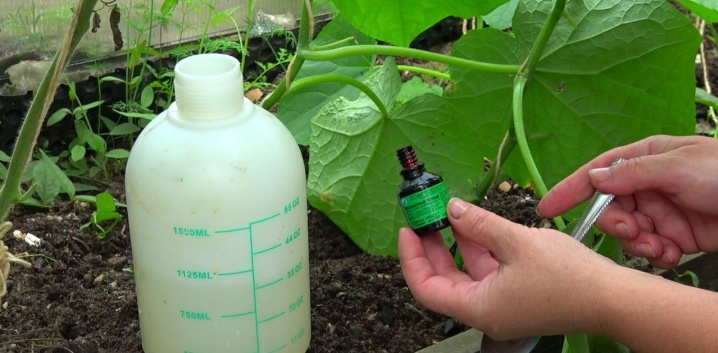
You can add an infusion of chicken manure or dung under the root, followed by spraying the leaves with solutions of trace elements. Water the soil with herbal infusion diluted with water 1: 5. Drizzle with diluted yeast and sprinkle with a weak solution of poultry droppings.
Add mineral solutions under the root, which are prepared per bucket of water:
- from a mixture of potassium sulfate (15 g) and superphosphate (30 g);
- from potassium nitrate - from 25 to 30 g;
- from urea - 50 g.
Spray the green mass with urea in a proportion of 15 g / 10 l of water.

The fourth feeding is carried out in order to prolong fruiting. Most often, complex mineral compositions and organics are used:
- watered with infusions: daily manure (1 kg / bucket of water) or 2 days of rotted hay;
- fertilize with a mixture of manure and ash;
- sprayed with soda solution (20-30 g / 10 l) or urea (15 g / 10 l).
Cucumbers grown in a polycarbonate greenhouse also need feeding, there should be at least 4-5 of them.
The first step is to prepare the soil in the greenhouse. To do this, about 20-30 g of ammonium nitrate and 20 g of simple superphosphate and potassium sulfate should be added to the soil in about a week.
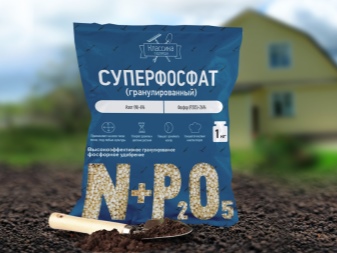

This is the recommended fertilization schedule.
- 14 days after transplanting seedlings into the greenhouse nitrogen-potash compositions should be added. For example, an aqueous (per bucket of water) complex solution consisting of nitrate (10 to 15 g), double superphosphate (20 to 25 g) and potassium chloride (10-15 g). You can also use one of the types of organic matter: aqueous solutions of liquid manure (1: 8), chicken manure (1:15) or herbal infusion (1: 5).
- After the period of mass flowering begins, feeding with potassium and nitrogen, magnesium and boron is necessary. The following aqueous solutions of mineral mixtures are used: superphosphate (40 g), potassium nitrate (20 g) and ammonium nitrate (30 g).
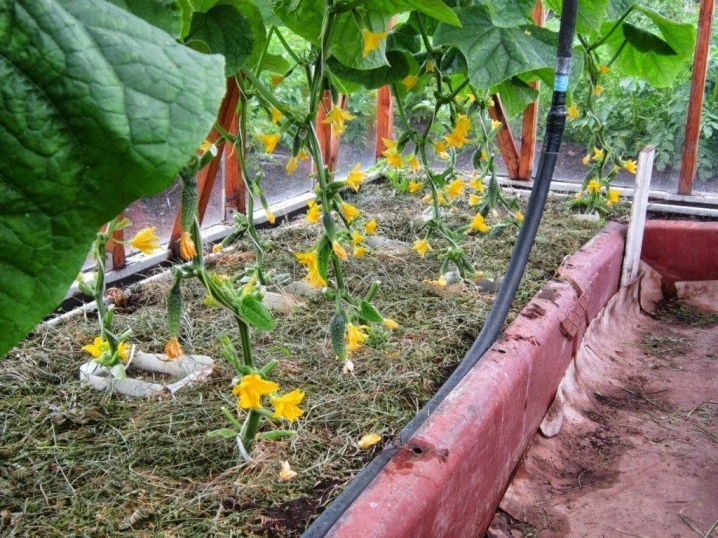
The following fertilization methods are also used:
- the bed is sprinkled with a mixture of dry ash and superphosphate, and then the soil is loosened;
- watered with an aqueous solution of ash (1 glass of ash / bucket of water);
- spraying with solutions: superphosphate (35 g / 10 l of water), boric acid (1 tsp) and potassium permanganate (about 12 crystals) per 1 l of water.
When the ovaries appear, organic feeding is recommended:
- chicken droppings are first diluted in water in a ratio of 1:15, and then again diluted with a bucket of water and 1 glass of ash is added;
- add 500 g of liquid mullein to a bucket of water, 1 tbsp. l. nitrophosphate and 1 glass of ash.
For 1 square meter, about 3 liters of these solutions will be required.
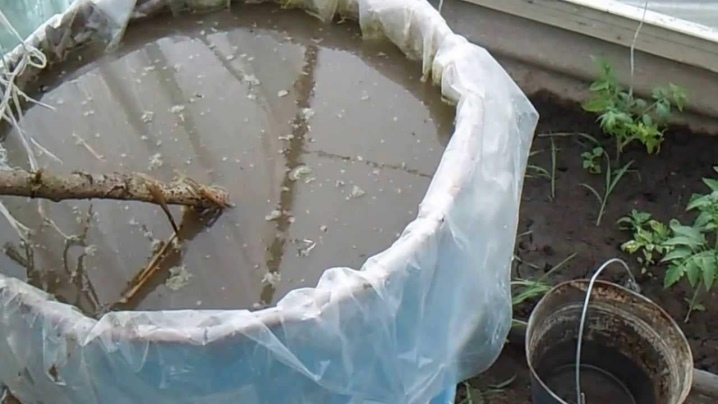
At the stage of mass ripening, fruits should be fertilized with mineral compounds: with aqueous solutions (per 10 l): urea (5 g), potassium nitrate (30 g). And also organic: aqueous solutions of herbal, ash infusions and mullein in a ratio of 1: 5.
For 1 square meter, about 8 liters of organic solutions are needed.

Depending on the type of soil
On nutrient-rich soils, cucumbers can produce high yields without additional feeding. Fertile chernozem lands are allowed to be fertilized no more than 2 times a season, while the volume of organic fertilizers in the form of manure is significantly reduced. In non-chernozem, especially podzolic lands, it is recommended to apply manure in the spring.
Cucumbers love light, loamy soil with a neutral pH.... Soils of sandy and sandy loam type are characterized by a low content of magnesium. Therefore, it is imperative and regular to add potassium magnesium to nutrient mixtures. After the flowering of cucumbers has begun, feeding should be carried out with a composition including 15 g of urea, 15 g of potassium sulfate and 25 g of potassium magnesium, dissolved in 10 liters of water.
In soils with high acidity, in order to reduce it, it is recommended to add 0.5 kg of dolomite flour per 1 sq. m... Also, acidic soils have a low calcium content, and this must be taken into account when feeding. On weakly acidic soils, liming should be carried out: lime is introduced in the fall during digging.
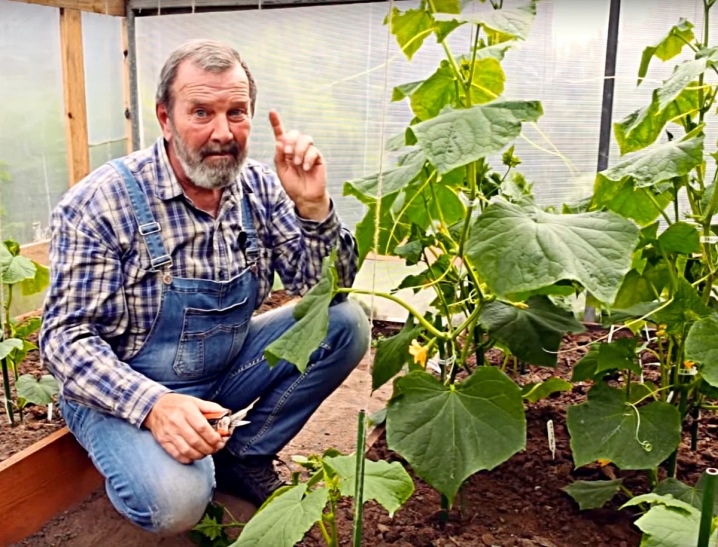
Folk remedies
In addition to traditional methods of fertilizing cucumbers, gardeners often use original folk remedies.
Yeast feeding
Yeast has a stimulating effect on plant development. They are used for both watering and spraying. Fertilizer is prepared as follows: 0.5 kg of yeast and 2/3 cup of sugar must be dissolved in water (warm), stirring thoroughly.
Then the mixture is allowed to brew in a warm room for 3 days, stirring it periodically. Before use, it should be diluted in a ratio of 250 g / 10 l of water. Consumption rate - 1/2 l for a bush.
Cucumbers can be sprayed with the same solution after straining.
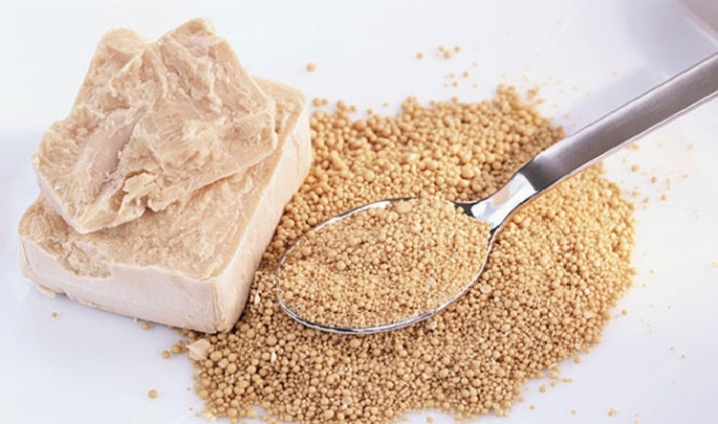
A solution of ammonia
Ammonia it is recommended to feed at the initial stage to activate the growth of green massbecause it has a high nitrogen content. And therefore, when using it, it is necessary to adhere exactly to the proportions so as not to harm the vegetable.
For root feeding, prepare a solution of 1/2 tsp. alcohol and 3 liters of water. Fertilize with a sprayer, moistening the ground under the cucumbers. For spraying, use the following solution: 3 tbsp. l. alcohol / bucket of water. Fertilizing with ammonia in the initial period is done once a week, and in the phase of active development of cucumbers, spraying can be carried out after 4 days.
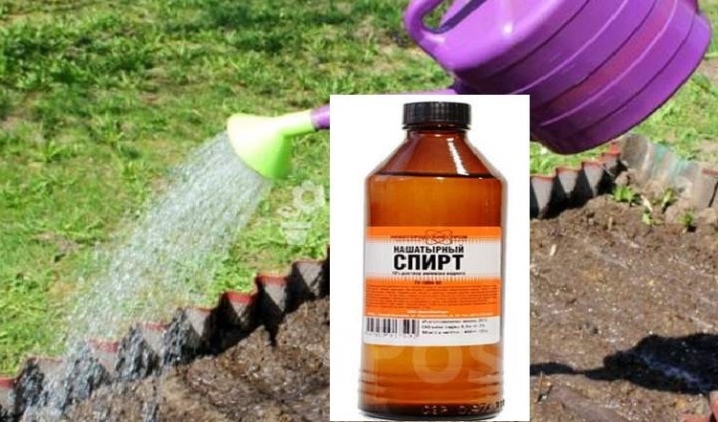
Egg shell feeding
The shell is used in the form of infusions for watering the soil. The dried shell of 5 eggs should be ground into powder, pour 1 liter of boiling water and let it brew for 5 days. Before use, the finished infusion is diluted with water again (1: 5).
For the preparation of infusions, decoctions and aqueous solutions are also used:
- dry onion peel, a decoction of which not only nourishes, but also has a preventive effect against many diseases;
- bread;
- iodine, which can be added to other nutritional formulations and used as an aqueous solution;
- baking soda;
- banana peel.
The following video will tell you about feeding cucumbers with folk remedies.













The comment was sent successfully.